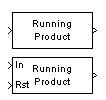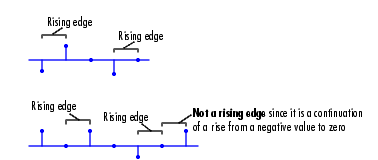

| DSP Blockset |   |
Compute the cumulative product of channel, column, or row elements
Library
Math Functions / Math Operations
Description
The Cumulative Product block computes the cumulative product of elements in each channel, column, or row of the M-by-N input matrix.
The inputs can be sample-based or frame-based vectors and matrices. The output always has the same size, dimension, rate, frame status, data type, and complexity as the input.
Sections of This Reference Page
Input and Output Characteristics
Valid Input to Multiply. The block computes the cumulative product of both sample- and frame-based vector and matrix inputs. Inputs can be real or complex. When multiplying along channels or columns, 1-D unoriented vectors are treated as column vectors. When multiplying along rows, 1-D vectors are treated as row vectors.
Valid Reset Signal. The optional reset port, Rst, accepts scalar values, which can be any built-in Simulink data type including Boolean. The rate of the reset signal must be a positive integer multiple of the rate of the data signal input.
Output Characteristics. The output always has the same size, dimension, rate, frame status, data type, and complexity as the data signal input.
Multiplying Along Channels
When the Multiply input along parameter is set to Channels (running product), the block computes the cumulative product of the elements in each input channel. The running product of the current input takes into account the running product of all previous inputs. See the following sections for more information:
Multiplying Along Channels of Frame-Based Inputs. For frame-based inputs, the block treats each input column as an independent channel. As the following figure and equation illustrate, the output has the following characteristics:
Given an M-by-N frame-based input, u, the output, y, is a frame-based M-by-N matrix whose first row has elements

Multiplying Along Channels of Sample-Based Inputs. For sample-based inputs, the block treats each element of the input matrix as an independent channel. As the following figure and equation illustrate, the output has the following characteristics:
Given an M-by-N sample-based input, u, the output, y, is a sample-based M-by-N matrix with the elements

For convenience, length-M 1-D vector inputs are treated as M-by-1 column vectors when multiplying along channels, and the output is a length-M 1-D vector.

Resetting the Cumulative Product Along Channels. When you set the Multiply input along parameter to Channels (running product), you can set the block to reset the running product whenever it detects a reset event at the optional Rst port. The rate of the reset signal must be a positive integer multiple of the rate of the data signal input. The input to the Rst port can be of the Boolean data type.
When the block is reset for sample-based inputs, the block initializes the current output to the values of the current input. For frame-based inputs, the block initializes the first row of the current output to the values in the first row of the current input.
The Reset port parameter specifies the reset event, which can be one of the following:
Rst port.
Rst input does one of the following:

Rst input does one of the following:
Rst input is a Rising edge or Falling edge (as described above).
Rst input is not zero.
| Note When running simulations in the Simulink MultiTasking mode, sample-based reset signals have a one-sample latency, and frame-based reset signals have one frame of latency. Thus, there is a one-sample or one-frame delay between the time the block detects a reset event, and when it applies the reset. For more information on latency and the Simulink tasking modes, see Excess Algorithmic Delay (Tasking Latency) and the topic on the Simulation Parameters dialog box in the Simulink documentation. |
Multiplying Along Columns
When the Multiply input along parameter is set to Columns, the block computes the cumulative product of each column of the input, where the current cumulative product is independent of the cumulative products of previous inputs.
The output has the same size, dimension, frame status, data type, and complexity as the input. The mth output row is the element-wise product of the first m input rows.
Given an M-by-N input, u, the output, y, is an M-by-N matrix whose jth column has elements

The block treats length-M 1-D vector inputs as M-by-1 column vectors when multiplying along columns.

Multiplying Along Rows
When the Multiply input along parameter is set to Rows, the block computes the cumulative product of the row elements, where the current cumulative product is independent of the cumulative products of previous inputs.
The output has the same size, dimension, frame status, and data type as the input. The nth output column is the element-wise product of the first n input columns.
Given an M-by-N input, u, the output, y, is an M-by-N matrix whose ith row has elements

The block treats length-N 1-D vector inputs as 1-by-N row vectors when multiplying along rows.
Dialog Box
Supported Data Types
| Input and Output Ports |
Supported Data Types |
Data input port, In |
|
Reset input port, Rst |
All built-in Simulink data types: |
| Output port |
Always has same data type as data input |
To learn how to convert to the above data types in MATLAB and Simulink, see Supported Data Types and How to Convert to Them.
See Also
| Cumulative Sum |
DSP Blockset |
| Matrix Product |
DSP Blockset |
cumprod |
MATLAB |
Also see Math Operations for a list of all the blocks in the Math Operations library.
 | Create Diagonal Matrix | Cumulative Sum |  |